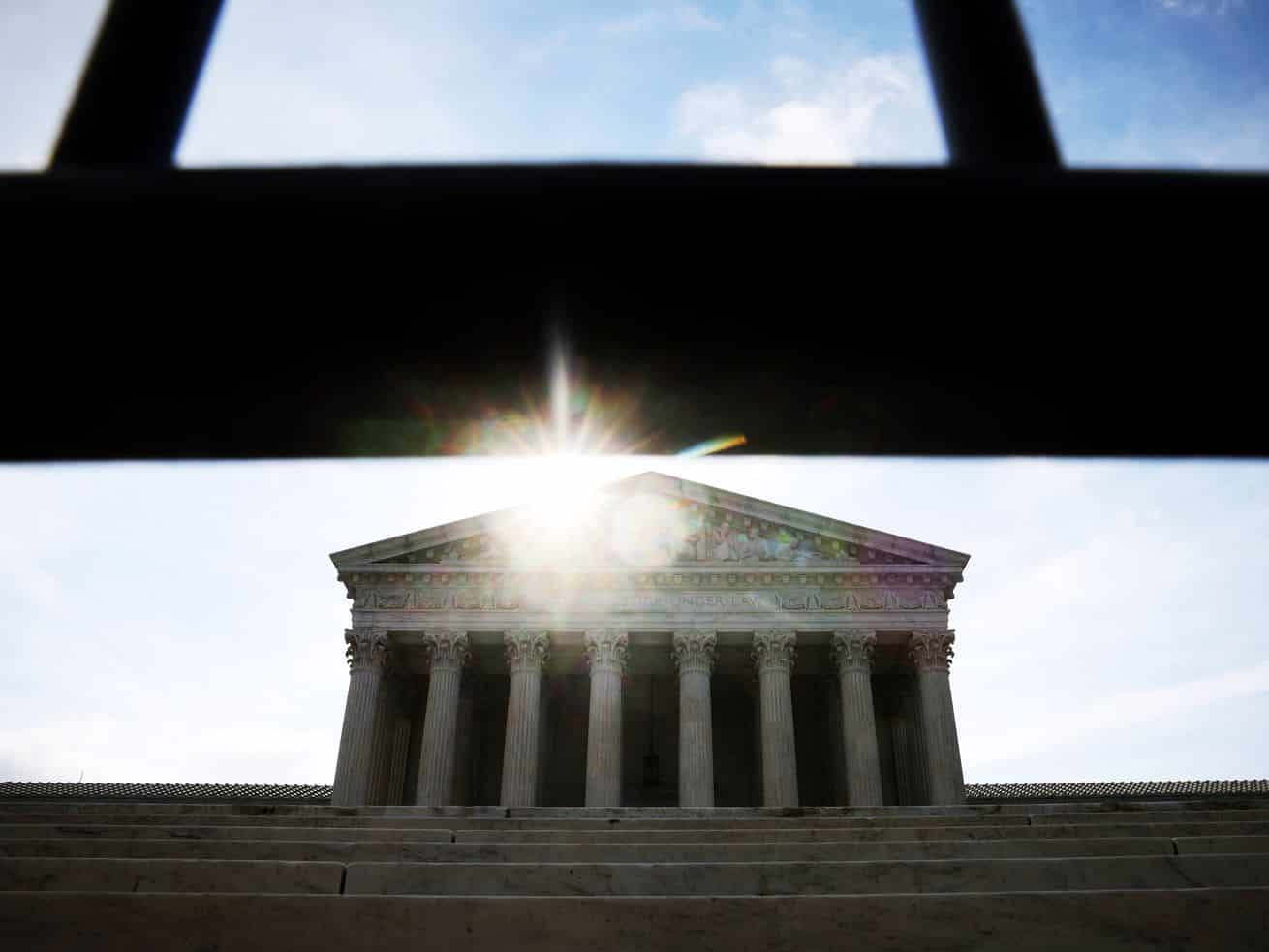The biggest loser was democracy.
The Supreme Court just completed its first term since liberal Justice Ruth Bader Ginsburg’s death, and her speedy replacement with conservative Justice Amy Coney Barrett. So the preeminent question on many court-watchers’ minds was just how many victories the Republican Party — and the conservative movement more generally — would rack up in a 6-3 conservative Court.
The answer to that question is that Republicans probably got about 80 to 90 percent of what they realistically could have expected. The Court did not neutralize the entire Voting Rights Act, as some Republican litigants basically asked the Court to do, but it hamstrung the one remaining provision it had thus far left intact. The Court also targeted labor unions. It hung a sword of Damocles over laws requiring political campaigns to disclose their donors. And it revolutionized much of the Court’s religion jurisprudence, handing big victories to the Christian right in the process.
The term was not a clean sweep for conservatives. But the few high-profile victories for liberals were either very narrow or involved frivolous legal claims that no reasonable judge would endorse. The Court, for example, dismissed an attack on the Affordable Care Act that was widely mocked even by prominent critics of Obamacare. (It’s also normal for conservatives to lose a few high-profile cases after the Court takes a significant rightward turn, because partisan lawyers are more likely to make more dubious legal arguments when they think the Court is on their side.)
As several commentators have noted, the Court did seem to divide into three camps for much of the term. The three liberal justices struggled to hold back a growing right-wing tide, while Justices Clarence Thomas, Samuel Alito, and Neil Gorsuch often pushed for bigger and more legally dubious conservative victories. That left Chief Justice John Roberts, Justice Brett Kavanaugh, and Barrett in the middle.
/cdn.vox-cdn.com/uploads/chorus_asset/file/22694801/GettyImages_1232480847t.jpg) Erin Schaff-Pool/Getty Images
Erin Schaff-Pool/Getty ImagesBut the biggest takeaway from this term is that the Court’s middle is really far to the right. If you’re a conservative, and your biggest complaint about the Supreme Court is that a majority of the justices rejected an anti-Obamacare lawsuit that many Republicans tried to distance themselves from, you don’t have much to complain about.
Loser: Democracy
Roberts has spent much of his career crusading against voting rights, specifically the Voting Rights Act of 1965, the landmark civil rights law that ended Jim Crow practices disenfranchising Black voters and prohibiting race discrimination of all kinds in elections.
As a young Justice Department lawyer, Roberts fought unsuccessfully to convince President Ronald Reagan to veto an important 1982 amendment to the law, which overturned a previous Supreme Court decision making it very difficult to win Voting Rights Act lawsuits. As a justice, Roberts wrote the Court’s decision in Shelby County v. Holder (2013), which neutralized much of the law. He also joined two other opinions severely weakening the rest of the law — the latter of which, Brnovich v. DNC, was decided on the last day of this term.
The practical impact of this trilogy is that the Voting Rights Act is barely alive. Under Brnovich, for example, states are likely to have carte blanche to roll back early voting and absentee voting, as well as other, similar innovations that became common in the last four decades. And most challenges to the latest wave of Republican voter suppression laws are likely to fail.
/cdn.vox-cdn.com/uploads/chorus_asset/file/22695178/GettyImages_1233687451t.jpg) Stefani Reynolds/Bloomberg via Getty Images
Stefani Reynolds/Bloomberg via Getty ImagesAnd, on top of all of that, the Court’s decision in Americans for Prosperity Foundation v. Bonta, in Justice Sonia Sotomayor’s words, places a “bull’s-eye” on all laws requiring political organizations and campaigns to disclose their donors.
Simply put, the Court moved the country several steps closer to competitive authoritarianism this term.
Winner: The shadow docket
The “shadow docket” refers to an array of emergency motions, requests to stay lower court opinions, and other Supreme Court orders handed down without following the Court’s ordinary deliberative procedures. The Court typically spends months pondering cases that receive full briefing and oral argument before the justices. Shadow docket cases, by contrast, are often decided in mere days — meaning that they can often lead to haphazard decision-making if the justices are insufficiently cautious.
This risk was on full display this past term, as the Court appeared to take one, extraordinarily aggressive approach in the religion cases that arose on its shadow docket, while also being much more cautious in a case that was briefed and argued.
One of the biggest surprises from this past term was the Court’s narrow decision in Fulton v. City of Philadelphia — a potentially very significant religion case that arose on the Court’s ordinary docket. Fulton was decided after the Court handed down several transformative victories for the religious right in shadow docket cases. And these shadow docket cases ruled in favor of religious objectors, holding that churches and other houses of worship could ignore public health regulations intended to prevent the spread of Covid-19.
The stakes in Fulton were enormous — though not quite as enormous as the shadow docket cases about whether public health officials may limit the spread of a deadly disease. Fulton presented the question of whether people with religious objections to homosexuality have a constitutional right to discriminate against same-sex couples.
Yet, rather than following the path laid out in its shadow docket decisions this term, Fulton ended instead with a whimper. The Court decided the case on such fact-specific grounds that it is far from clear that the majority opinion has any implications at all for future cases.
It’s not at all clear what to make of this outcome, but one possible explanation is that, when it chose to decide important cases very quickly — as it did in its shadow docket religion cases — the justices rushed to an outcome that they would have avoided if they’d taken more time to think.
As Sotomayor wrote in a 2020 opinion warning that her Court is too eager to decide important cases without adequate deliberation, shadow docket cases can “force the Court to consider important statutory and constitutional questions that have not been ventilated fully in the lower courts, on abbreviated timetables and without oral argument.”
Although three justices — Thomas, Alito, and Gorsuch — would have given religious conservatives the sweeping legal immunity they sought in Fulton, Barrett wrote a brief concurring opinion explaining that she was unwilling to overrule a three-decade-old precedent denying such immunity to religious objectors until she had a better sense of what should replace that precedent.
For Barrett, at least, the opportunity to spend months, instead of mere days, thinking about Fulton appears to have stirred her to caution.
It remains to be seen whether the Court will heed Sotomayor’s warnings about deciding major cases on the shadow docket in the future. In this past term, however, the Court was quite willing to make sweeping decisions with minimal deliberation.
Loser: Samuel Alito
Justice Samuel Alito is the Court’s most reliable partisan, and that’s especially true in cases involving the Affordable Care Act. Last term, Alito was the sole dissenting voice in an 8-1 decision rejecting a $12 billion scheme by Republicans to sabotage Obamacare. Overall, he’s heard four Obamacare cases and ruled in favor of the side seeking to undermine the law every single time.
/cdn.vox-cdn.com/uploads/chorus_asset/file/22694826/GettyImages_56873492t.jpg) Ken Heinen/Supreme Court Pool via Getty Images
Ken Heinen/Supreme Court Pool via Getty ImagesYet California v. Texas, the most recent of these cases (the Court voted 7-2 to reject this latest attack on Obamacare earlier this month) was unlike the others in that much of the conservative movement spent the past couple of years trying to distance itself from the unusually weak legal arguments presented in that case. The Wall Street Journal’s editorial board, ordinarily a strident foe of the Affordable Care Act, labeled the case the “Texas Obamacare Blunder.”
Indeed, the Texas case, which was brought by 18 Republican state attorneys general and backed by the Trump administration, inspired a bizarre spectacle during Barrett’s confirmation hearing last fall — where Senate Democrats warned that Barrett could vote to strike down Obamacare, while their Republican counterparts rushed to Barrett’s defense by predicting that their own party’s lawsuit would flop. In the end, Barrett voted to dismiss the case for lack of jurisdiction.
Alito, by contrast, was one of two votes to strike down Obamacare almost in its entirety (Gorsuch was the other), and he explained his vote in an opinion that was widely mocked, even by his conservative allies. Jonathan Adler, one of the architects of a previous lawsuit seeking to sabotage the Affordable Care Act, wrote that the better parts of Alito’s opinion “cannot work the way that Justice Alito wants it to,” and that the least persuasive parts “are inexplicably shallow and poorly argued.” National Review’s Robert VerBruggen wrote that “the worst thing about the decision is that two conservative justices, Samuel Alito and Neil Gorsuch, mostly bought the lawsuit’s preposterous arguments.”
The thrust of Alito’s dissenting opinion in Texas was that an amended provision of the Affordable Care Act that literally does nothing is unconstitutional, and that the appropriate response is to invalidate nearly all of Obamacare.
It may seem odd to include Alito on a list of losers, since he was the author of Brnovich and his Republican Party saw many significant victories this term, but the justice beclowned himself with his Texas opinion. It was the sort of opinion that is so poorly reasoned, it makes you question his fitness for judging.
Winner: Student-athletes
I will confess that I did not see the Supreme Court’s unanimous decision striking down many of the NCAA’s limits on college athlete compensation coming.
The Court’s decision in National Collegiate Athletic Association v. Alston is fairly straightforward. Federal antitrust law typically prevents competitors from colluding with each other to set prices, including the price of labor. But the NCAA sets labor prices for the entire college sports industry. Under the normal rules that apply to any other industry, that’s simply not allowed.
But for the past several decades, antitrust law — and especially conservative judges tasked with interpreting antitrust law — was heavily influenced by a 1978 book by the late Robert Bork, a judge whose failed Supreme Court nomination in 1987 transformed him into a right-wing martyr. Bork advanced the proposition that companies should be free to collude so long as their behavior does not lead to higher prices for consumers. And there’s no reason to believe that poorly compensated athletes drive up costs for college basketball or football fans.
/cdn.vox-cdn.com/uploads/chorus_asset/file/22695150/GettyImages_466914234t.jpg) Mike Ehrmann/Getty Images
Mike Ehrmann/Getty ImagesThere’s even a 1984 Supreme Court decision, NCAA v. Board of Regents of the University of Oklahoma, which cites Bork for the proposition that sports leagues should be exempted from many restrictions that antitrust law imposes on other businesses.
But the NCAA didn’t just lose its bid for an antitrust exemption before the Supreme Court — it lost badly in a unanimous decision written by Gorsuch, one of the Court’s most conservative members.
It remains to be seen whether Alston represents a sea change in how the Court’s right flank approaches antitrust suits, or whether it will be unwilling to apply antitrust law to most corporations with the same vigor that it applied it to universities. But Alston is a possible sign that Bork’s consumer-focused vision of antitrust law may be losing its grip over the Court.
Additionally, the Court handed a victory to public school student-athletes — and to students generally — who find themselves on the wrong end of overly censorious school administrators. Mahanoy Area School District v. B.L. involved a cheerleader who was suspended from her school’s JV cheerleading squad after she posted a vulgar Snapchat message complaining that she did not make the varsity team.
Though Justice Stephen Breyer’s opinion for the Court is fairly measured, it makes clear that “courts must be more skeptical of a school’s efforts to regulate off-campus speech.”
Loser: Unions
Few jobs are more thankless than representing unions before the Supreme Court.
Three years ago, in Janus v. AFSCME (2018), the Court voted along party lines to cut off a major source of funding for public sector unions. Janus was the culmination of several years of decisions undercutting unions, and it overruled a 41-year-old precedent to boot.
This term, the Court showed similar disregard for precedent in Cedar Point Nursery v. Hassid, which struck down a nearly half-century-old California regulation that permitted union organizers to temporarily enter farm worksites and speak to workers while they were not actually working.
Cedar Point effectively abandoned a framework the Court has applied to unions that wish to speak to workers on company property since 1956. It also completely reworked a long line of precedents governing when landowners can exclude someone from their land. But it’s far from clear whether the new rule announced in Cedar Point will be applied very often outside of the union context.
Under this new rule, a law or regulation that “appropriates a right to invade” private property violates the Fifth Amendment’s takings clause, which prohibits the government from taking private property without “just compensation.” But Roberts’s majority opinion in Cedar Point also carved out a number of exceptions to this rule, which, taken to its logical extreme, would have made it unconstitutional for the government to require restaurants to admit health inspectors.
Though Roberts attempted to articulate a rule governing when such exceptions would apply, his explanation was little more than word salad (exceptions must bear “an ‘essential nexus’ and ‘rough proportionality’ to the impact of the proposed use of the property”). In the end, the Court made a value judgment that health inspections are sufficiently important that they should continue, but union organizing is not.
Winner: The Republican Party
No political party can expect the Supreme Court to rule in its favor in every single case, even if that party did appoint a supermajority of the justices. As Dartmouth professor of government Brendan Nyhan wrote after the Court had an unexpectedly liberal term in 2015, “the court’s recent decisions may reflect a change in the cases being considered by the court rather than a shift in the preferences of the justices.”
That is, as the Court moves right, conservative lawyers will likely bring more dubious cases, while smart liberal lawyers will avoid federal court unless they are sure their case is airtight. It is hard to imagine, for example, that the 18 Republican attorneys general that brought the Texas case would even have considered filing that lawsuit unless they believed (in this case, erroneously) that the Supreme Court was in their pocket.
/cdn.vox-cdn.com/uploads/chorus_asset/file/22695191/GettyImages_1229181305t.jpg)
It’s also common for the Court to hand down a few fairly moderate decisions relatively early in the term before pivoting to its most contentious cases. The justices typically spend more time on the cases that produce the starkest ideological divisions, handing down most of them in the final weeks of the term.
And yet, in a term gravid with extraordinarily aggressive arguments made by right-wing lawyers, conservatives and Republicans had an exceptionally good run. They convinced the Court to hobble the Voting Rights Act, to open a new line of attack on donor disclosure laws, to expand property rights, to attack unions, and to rewrite the rules governing when religious objectors are exempt from the law.
And that’s after just one term with a 6-3 Court. Next term, the Court will hear a case that could overrule Roe v. Wade.
Author: Ian Millhiser
Read More



